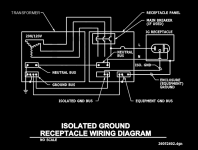dvcraven052256
Member
- Location
- St. Louis, missouri
- Occupation
- Electrical Engineer
I have a project where isolated ground receptacles are call for from the AV engineer. They eliminated the ISO transformer because of cost but the IG receptacles remain.
Frankly I don't understand the use of IG receptacles. In essence all goes back to the N-G connections at the transformer or service anyway so do you really gain anything the IG devices.
I look forward to any comments.
Dan Craven
Kaemmerlen Electric
Frankly I don't understand the use of IG receptacles. In essence all goes back to the N-G connections at the transformer or service anyway so do you really gain anything the IG devices.
I look forward to any comments.
Dan Craven
Kaemmerlen Electric

